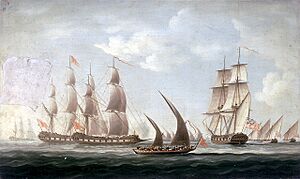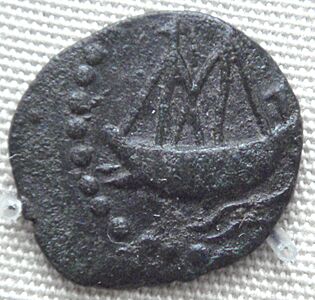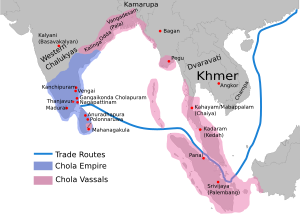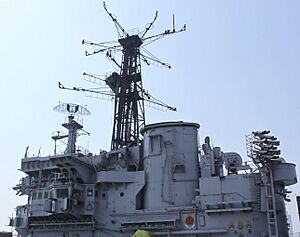History of the Indian Navy facts for kids
India has a long and exciting history of powerful navies! For many centuries, different empires and kingdoms in India had their own fleets of ships. These navies helped them trade, explore, and even defend their lands or expand their influence across the seas.
For example, the Chola Empire used its strong navy to reach faraway places like Southeast Asia. Later, the Maratha Navy and the Marakkar Navy fought against both Indian and European powers. The East India Company, a British trading company, even created its own navy, called the Bombay Marine.
After the Indian Rebellion of 1857, when the British took more control, this small navy grew and changed names several times, eventually becoming the "Royal Indian Marine." During World War I, this navy helped transport many Indian soldiers overseas. In World War II, it became the Royal Indian Navy and took part in important battles and patrols.
When India became independent in 1947, the navy was divided. The part that stayed with India became the Indian Navy in 1950. Since then, the Indian Navy has been involved in important events like Operation Vijay in 1961 and wars with Pakistan in 1965 and 1971. It also helps with smaller missions today.
Contents
-
An ancient Indian ship on a coin from the 1st-2nd century CE. This shows how good the Sātavāhana Empire was at sailing and trading.
-
A painting from the Ajanta Caves (around 5th century) showing a ship with three masts.
India's amazing sea history goes back 5,000 years! Imagine, the world's first tidal dock (a special harbor that uses tides) might have been built in Lothal around 2300 BCE. This was during the time of the Indus Valley Civilization, near what is now the Mangrol harbor.
Ancient texts like the Rig Veda, written thousands of years ago, talk about sea routes and naval trips. A small bronze ship model from around 1500-500 BCE was found in West Bengal, showing that people were building ships a very long time ago.
Around the 4th century BCE, a wise man named Kautilya wrote in his book, Arthashastra, about protecting the empire's ships. Another writer, Megasthenes, mentioned that the military had six main groups, and one of them was the navy!
During the Mauryan Empire, Indians were already trading by sea with countries in Southeast Asia, like Thailand and Malaysia. Indian seals and writings have been found in ancient port cities there. For many centuries, sea lanes were the main way for trade, helping Indian culture spread across the Indian Ocean region. Powerful navies were built by kingdoms like Kalinga, Maurya, Satavahana, Chola, Vijayanagara, Maratha, and Mughal empires. The Cholas were especially good at sea trade and even reached China.
Ships in Ancient India
The Arthashastra also talks about a "superintendent of ships" who looked after ports and ensured the safety of sea traders. It named four types of ships:
- Commercial ships (for trade and passengers)
- Private ships
- Royal ships
- Warships (called Himsrika)
By the 6th century AD, ships were a very important part of the Indian military.
The Chola Empire became a huge naval power under two great kings: Raja Raja Chola (who ruled from 985–1014) and his son Rajendra Chola (who ruled from 1012–1044).
Under Rajendra Chola, the Cholas used their strong navy to expand their empire. They took control of many kingdoms in South-East Asia, including parts of Myanmar, Malaya, and Sumatra. They even sent ambassadors to faraway countries like China.

In 1503, the ruler of Kozhikode, Manavikraman, started building up his navy. He did this because the Portuguese were trying to control trade. He appointed Kunjali Marakkar as the admiral (leader) of his fleet.
For the next 100 years, the rulers of Kozhikode, with the help of four generations of Kunjali Marakkars, successfully fought off the Portuguese. However, there were disagreements between Mohammed Ali, the fourth Marakkar, and his rulers. He even declared himself the "Lord of the Indian seas." Because of this, the rulers of Kozhikode teamed up with the Portuguese to defeat Mohammed Ali in 1600. Later, they even allied with the Dutch East India Company to defeat the Portuguese.

The Mughal Empire also had a navy, though it was not as strong as its army. The navy mainly patrolled the coast. It was involved in important battles like the Siege of Hooghly and the Anglo-Mughal War.
One famous naval campaign was against the kingdom of Arakan. In 1665, Emperor Aurangzeb sent his governor, Shaista Khan, with 288 ships and over 20,000 men to stop pirates and capture Chittagong.
During the Mughal Empire, the region of Bengal Subah was known for its large shipbuilding industry. Historians believe Bengal built about 223,250 tons of ships every year in the 16th and 17th centuries!
The Mughals sometimes struggled to build a strong navy, not because of a lack of money, but because they didn't have enough skilled people to lead the ships. However, Aurangzeb did work with the British to capture Janjira island, and he also teamed up with the Siddi community's navy from Janjira State, who were very good sailors and fought against the Marathas.
Empress Mariam-uz-Zamani owned huge trade ships, including the Rahīmī and the Ganj-i-Sawai. The Rahimi was so large that sailors could spot it from miles away. After it was attacked by pirates, it was replaced by the Ganj-i-Sawa, which was also later attacked by the English pirate Henry Every.
The Maratha Empire was started by Chhatrapati Shivaji Maharaj in 1674. From the very beginning, the Marathas built a navy with cannons on their ships. The Maratha Navy became very powerful under Kanhoji Angre. He controlled the western coast of India from Mumbai to Vengurla.
Until his death in 1729, Kanhoji Angre often attacked European merchant ships. He captured many cargo ships from different East India Companies and demanded money for their return. In 1721, the Portuguese and British tried to stop him with a combined fleet of 6,000 soldiers and several warships, but they failed. Kanhoji continued to capture ships until he died.
The Maratha Navy used different types of ships:
- Grabs: These were cannon-armed warships with a single deck.
- Pals: These were larger warships, like men-of-war.
- Gallivats: These were small boats with lateen sails, armed with small guns. They helped the larger 'Grabs'.
The Bombay Marine is Formed
The English East India Company was set up in 1600. In 1612, Captain Thomas Best defeated the Portuguese in a sea battle. This battle, along with the problem of piracy, led the English East India Company to create a small navy to protect its trade. This force was based near Surat and was called the Honourable East India Company's Marine. The first warships arrived on September 5, 1612.
This navy protected merchant ships in the Gulf of Cambay and on the Tapti and Narmada rivers. They also helped map the coastlines of India, Persia, and Arabia.
In 1686, as most English trade moved to Bombay, the force was renamed the Bombay Marine. This navy fought against the Marathas and participated in the Anglo-Burmese Wars. The Bombay Marine hired many Indian sailors, but Indian officers were not allowed until 1928.
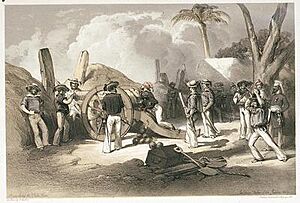
In 1830, the Bombay Marine was renamed His Majesty's Indian Navy. When the British captured Aden, the navy's duties increased, leading to the creation of the Indus Flotilla. The Navy also fought in the China War in 1840.
The navy went back to being called the Bombay Marine from 1863 to 1877, then became Her Majesty's Indian Marine. It had two main bases: one in Calcutta and one in Bombay.
In 1892, because of its important service in various campaigns, Her Majesty's Indian Marine was given the title Royal Indian Marine. By this time, it had over 50 ships.
The Royal Indian Marine in World War I
During World War I, the Royal Indian Marine played a huge role in transporting Indian soldiers to France, Africa, and Mesopotamia. Just three weeks after the war started in 1914, the first group of Indian cavalry (soldiers on horseback) sailed to France.
Many ships were prepared for war at the Naval Dockyard in Bombay and the Kidderpore Docks in Calcutta. The Indian Marine also kept the harbors of Bombay and Aden safe by clearing mines from the water. Smaller ships patrolled important rivers like the Tigris and Euphrates to keep supply lines open for troops fighting in Mesopotamia. A hospital ship was also used to treat wounded soldiers.
By the end of the war in 1918, the Royal Indian Marine had transported or escorted over 1.3 million men, 172,815 animals, and millions of tons of war supplies. The Royal Indian Marine had 330 casualties, and 80 of its members received awards for their bravery. They were vital in supporting the Indian Army throughout the war.
The first Indian officer, Sub Lieutenant D.N Mukherji, joined the Royal Indian Marine as an engineer in 1928.


In 1934, the Royal Indian Marine changed its name to the Royal Indian Navy. It was officially started on October 2, 1934, in Bombay. Its ships were called HMIS, which stood for His Majesty's Indian Ship.
At the start of World War II, the Royal Indian Navy was small, with only eight warships. But the war made it grow incredibly fast! By 1943, there were twenty thousand people in the navy. During the war, the Women's Royal Indian Naval Service was created, allowing women to join the navy for the first time, though they did not serve on ships.
During the war, many new ships were built for the Royal Indian Navy in the United Kingdom. These included anti-aircraft sloops and minesweepers. Ships like HMIS Sutlej and HMIS Jumna helped defend against air attacks and U-boat attacks in the Atlantic. They also took part in Operation Husky, the Allied invasion of Sicily, providing air defense.
The Royal Indian Navy also helped protect convoys (groups of ships traveling together) in the Indian Ocean and Mediterranean Sea. They were very involved in the Burma Campaign, carrying out raids, attacking enemy shores, and supporting invasions.
During World War II, the Royal Indian Navy faced tough battles.
- The sloop HMIS Pathan was sunk by an Italian submarine in June 1940.
- On December 9, 1941, HMIS Prabhavati was accidentally sunk by a British ship that mistook it for a Japanese submarine.
- HMIS Indus was sunk by Japanese aircraft in April 1942.
But the Royal Indian Navy also had many successes:
- HMIS Jumna was very active in the Java Sea campaign in 1942. It shot down five Japanese aircraft between February 24 and 28, 1942.
- On November 11, 1942, HMIS Bengal was escorting a Dutch tanker when two Japanese ships attacked. Bengal and the tanker fought back, hitting and sinking one of the Japanese ships, the Hōkoku Maru.
- On February 12, 1944, the Japanese submarine RO-110 was sunk by HMIS Jumna and two Australian minesweepers.
- On August 12, 1944, the German submarine U-198 was sunk by HMIS Godavari and a British frigate.
The Mutiny of 1946
In February 1946, Indian sailors started a mutiny (a rebellion) on over fifty ships and in shore bases. They were protesting about things like slow demobilization (being released from military service) and unfair treatment. This mutiny gained a lot of support across India, even from parts of the Army and Air Force. A total of 78 ships, 20 shore bases, and 20,000 sailors were involved.
In 1947, India was divided into two new countries: India and Pakistan. The Royal Indian Navy was also split between them. British officers continued to serve in both navies for a while.
Here's a simple look at how the ships were divided:
| Vessel type | India | Pakistan |
|---|---|---|
| Frigates |
|
|
| Sloops |
|
|
| Corvettes |
|
|
| Minesweepers |
|
|
When India became a republic on January 26, 1950, the navy's name was changed to the Indian Navy. Its ships were then called Indian Naval Ships (INS).
Vice Admiral R. D. Katari became the first Indian Chief of Naval Staff on April 22, 1958.
Taking Goa, 1961
The Indian Navy's first big operation was in 1961, during Operation Vijay, to take control of Goa from the Portuguese Navy. The Portuguese had four frigates and several patrol boats there.
Only one Portuguese frigate, the NRP Afonso de Albuquerque, actually fought against Indian Navy ships. The Indian frigates INS Betwa and INS Beas destroyed the NRP Afonso. Parts of this ship are now in the Naval Museum in Mumbai.
Indo-Pakistani War of 1965
There weren't many big sea battles during the Indo-Pakistani War of 1965. On September 7, 1965, the Pakistani Navy briefly attacked the Indian coastal town of Dwarka. This was called Operation Dwarka. It didn't achieve its main goal of disabling the radar station. India didn't respond much because most of its naval ships were being repaired.
Indo-Pakistani War of 1971
The Indian Navy played a very important role in the 1971 war, especially by bombing Karachi harbor. On December 4, the navy launched Operation Trident. During this operation, Indian missile boats INS Nirghat and INS Nipat sank the minesweeper PNS Muhafiz and the destroyer PNS Khyber. Another destroyer, PNS Shahjahan, was badly damaged. Because of this success, December 4 is now celebrated as Navy Day in India.
This operation was so successful that the Pakistani Navy mistakenly attacked one of its own ships, PNS Zulfiqar, thinking it was an Indian missile boat.
During another operation on December 8, the Pakistani frigate PNS Dacca was severely damaged by INS Veer, and Karachi's oil storage was set on fire. An Indian frigate, INS Khukri, was sunk by a Pakistani submarine.
On the eastern side, the Pakistani submarine PNS Ghazi was sunk near Vishakhapatnam harbor. Indian naval aircraft from the aircraft carrier INS Vikrant helped sink many gunboats and merchant ships in the Bay of Bengal. The Indian Navy's successful blockade of East Pakistan (now Bangladesh) was a major reason for Pakistan's surrender.
Here's a summary of naval losses:
| Type of Vessel | Indian Navy losses | Pakistan Navy losses |
|---|---|---|
| Destroyers | 0 | 2 (PNS Khaibar and PNS Shahjahan*) |
| Frigates | 1 (INS Khukri) | 3 |
| Submarines | 0 | 1 (PNS Ghazi) |
| Minesweeper | 0 | 1 (PNS Muhafiz) |
| Navy Aircraft | 1 (Alize) | 0 |
| Patrol boats and Gunboats | 0 | 4 Gunboats and 3 patrol boats |
| Merchant navy and others | 0 | 9 (including one US ammunition ship) |
|
*PNS Shahjahan was likely damaged beyond repair. |
||
Operations After 1971
The Indian Navy has continued to be involved in important missions:
- Operation Cactus (1988): The Indian Armed Forces helped stop a coup attempt in the Maldives. Indian Navy frigates INS Godavari and INS Betwa captured a hijacked ship, rescued hostages, and arrested the mercenaries near the Sri Lankan coast.
- Operation Sukoon (2006): During the 2006 Lebanon War, the Indian Navy successfully evacuated 2,280 people from Lebanon, including Indian, Sri Lankan, Nepali, and Lebanese citizens.
- Anti-Piracy Missions (since 2008): Since November 2008, Indian Navy frigates like INS Tabar and INS Mysore have been on anti-piracy missions off the Gulf of Aden, helping to keep shipping lanes safe.
See also
- Indian Navy
- Indian Armed Forces
- Indian maritime history
- List of military operations of India
- Naval ranks and insignia of India


